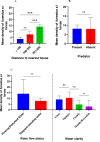Larval ecology and bionomics of Anopheles funestus in highland and lowland sites in western Kenya
- PMID: 34634069
- PMCID: PMC8504749
- DOI: 10.1371/journal.pone.0255321
Larval ecology and bionomics of Anopheles funestus in highland and lowland sites in western Kenya
Abstract
Background: An. funestus is a major Afrotropical vector of human malaria. This study sought to investigate the larval ecology, sporozoite infection rates and blood meal sources of An. funestus in western Kenya.
Methods: Larval surveys were carried out in Bungoma (Highland) and Kombewa (lowland) of western Kenya. Aquatic habitats were identified, characterized, georeferenced and carefully examined for mosquito larvae and predators. Indoor resting mosquitoes were sampled using pyrethrum spray catches. Adults and larvae were morphologically and molecularly identified to species. Sporozoite infections and blood meal sources were detected using real-time PCR and ELISA respectively.
Results: Of the 151 aquatic habitats assessed, 62/80 (78%) in Bungoma and 58/71(82%) in Kombewa were positive for mosquito larvae. Of the 3,193 larvae sampled, An. funestus larvae constitute 38% (1224/3193). Bungoma recorded a higher number of An. funestus larvae (85%, 95%, CI, 8.722-17.15) than Kombewa (15%, 95%, CI, 1.33-3.91). Molecular identification of larvae showed that 89% (n = 80) were An. funestus. Approximately 59%, 35% and 5% of An. funestus larvae co-existed with An. gambiae s.l, Culex spp and An. coustani in the same habitats respectively. Of 1,221 An. funestus s.l adults sampled, molecular identifications revealed that An. funestus constituted 87% (n = 201) and 88% (n = 179) in Bungoma and Kombewa, respectively. The Plasmodium falciparum sporozoite rate of An. funestus in Bungoma and Kombewa was 2% (3/174) and 1% (2/157), respectively, and the human blood index of An. funestus was 84% (48/57) and 89% (39/44) and for Bungoma and Kombewa, respectively.
Conclusion: Man-made ponds had the highest abundance of An. funestus larvae. Multiple regression and principal component analyses identified the distance to the nearest house as the key environmental factor associated with the abundance of An. funestus larvae in aquatic habitats. This study serves as a guide for the control of An. funestus and other mosquito species to complement existing vector control strategies.
Conflict of interest statement
The authors have no conflicts of interest to declare.
Figures






Similar articles
-
Resting behaviour of malaria vectors in highland and lowland sites of western Kenya: Implication on malaria vector control measures.PLoS One. 2020 Feb 25;15(2):e0224718. doi: 10.1371/journal.pone.0224718. eCollection 2020. PLoS One. 2020. PMID: 32097407 Free PMC article.
-
Composition of Anopheles mosquitoes, their blood-meal hosts, and Plasmodium falciparum infection rates in three islands with disparate bed net coverage in Lake Victoria, Kenya.Malar J. 2017 Sep 8;16(1):360. doi: 10.1186/s12936-017-2015-5. Malar J. 2017. PMID: 28886724 Free PMC article.
-
Indoor and outdoor malaria vector surveillance in western Kenya: implications for better understanding of residual transmission.Malar J. 2017 Nov 6;16(1):443. doi: 10.1186/s12936-017-2098-z. Malar J. 2017. PMID: 29110670 Free PMC article.
-
Surveillance of malaria vector population density and biting behaviour in western Kenya.Malar J. 2015 Jun 17;14:244. doi: 10.1186/s12936-015-0763-7. Malar J. 2015. PMID: 26082138 Free PMC article.
-
Impact of insecticide-treated bed nets on malaria transmission indices on the south coast of Kenya.Malar J. 2011 Dec 13;10:356. doi: 10.1186/1475-2875-10-356. Malar J. 2011. PMID: 22165904 Free PMC article.
Cited by
-
Differences in malaria vector biting behavior and changing vulnerability to malaria transmission in contrasting ecosystems of western Kenya.Parasit Vectors. 2023 Oct 21;16(1):376. doi: 10.1186/s13071-023-05944-5. Parasit Vectors. 2023. PMID: 37864217 Free PMC article.
-
Influence of larval growth and habitat shading on retreatment frequencies of biolarvicides against malaria vectors.Sci Rep. 2024 Jan 10;14(1):1002. doi: 10.1038/s41598-024-51152-1. Sci Rep. 2024. PMID: 38200070 Free PMC article.
-
Metabolic resistance to pyrethroids with possible involvement of non-coding ribonucleic acids in Anopheles funestus, the major malaria vector in western Kenya.BMC Genomics. 2025 Jan 23;26(1):64. doi: 10.1186/s12864-025-11260-2. BMC Genomics. 2025. PMID: 39849377 Free PMC article.
-
Influence of landscape heterogeneity on entomological and parasitological indices of malaria in Kisumu, Western Kenya.Parasit Vectors. 2022 Sep 27;15(1):340. doi: 10.1186/s13071-022-05447-9. Parasit Vectors. 2022. PMID: 36167549 Free PMC article.
-
Changes in contributions of different Anopheles vector species to malaria transmission in east and southern Africa from 2000 to 2022.Parasit Vectors. 2023 Nov 7;16(1):408. doi: 10.1186/s13071-023-06019-1. Parasit Vectors. 2023. PMID: 37936155 Free PMC article. Review.
References
-
- WHO, World malaria report 2020: 20 years of global progress and challenges. Geneva: World Health Organization; 2020. Licence: CC BY-NC-SA 3.0 IGO. 2020.
Publication types
MeSH terms
Substances
Grants and funding
LinkOut - more resources
Full Text Sources
Miscellaneous

